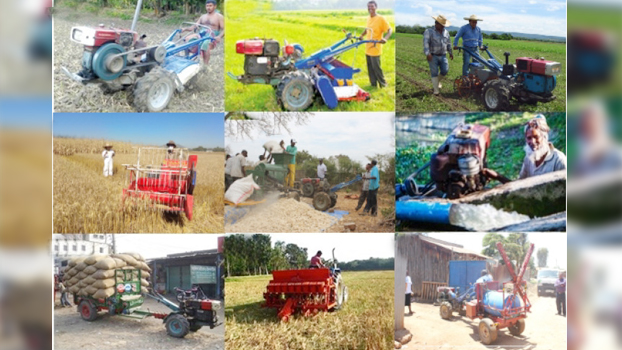Mechanisation making farm sector booming

Due to mechanization, the country’s agricultural sector is booming despite a reduction of arable land and other problems.
As a result of the multiple benefits of mechanization, farmers are increasingly turning to agricultural machinery. With the reduction in crop production using agricultural machinery, the time between planting from one crop to another has been reduced and farmers are now able to cultivate up to three to four crops a year instead of two.
This has not only saved production cost and increased production, it has also reduced the labour cost and land ploughing time between crops in a year.
Dr. Md. Nurul Hoque of the Department of Agriculture Engineering and Technology at Bangladesh Agricultural University (BAU) told Bangladesh Post, “Agriculture mechanization started in the late 60s, but after the taking oath of the present government, the mechanization process got a big boost. At present, 95 percent of the land preparation work in the country is being done with power tillers or tractors.
The use of machinery for fertilizer application and weed control has started and is expanding rapidly”.
“In the meantime, the use of reaper / combine harvester has started to be rented on a private or individual basis. In addition, about 95 percent of the machinery is being used for threshing, especially paddy, wheat, maize and all other grain crops,” added Dr. Md. Nurul Hoque.
“Often labor shortages during harvesting time largely damage crops which is a big tension for farmers. But this time what we see, 100 percent harvesting of Aus and Aman was completed using modern technology. This has saved time and energy of the farmers,” he further added.
According to a study by the Department of Agricultural Energy and Machinery of BAU, 65 to 95 percent of the country has been mechanized in terms of crop cultivation, irrigation, weeding, applying pesticides and threshing.
But the use of machinery for planting, fertilizing, harvesting, drying and sorting of products is negligible. Concerned companies said that the country is now creating a market for transplanters, harvesters, threshers, etc.
According to a report by the Department of Agricultural Extension (DAE), the use of agricultural machinery is most prevalent in land preparation before planting. In this case power tillers and tractors are being used in 90-95 percent of the land. The use of machinery for planting crops is still low as this machine is costlier and heavy.
The country’s agricultural machinery market is also increasing drastically.
According to BAU research, in the 2016-17 Financial Year, the market for agricultural machinery in Bangladesh was Tk 9,600 crore. Of this, 68 percent is imported and the rest is produced in the country.
According to the government, importer and local manufacturer of agricultural machinery, at present the market is worth Tk 10000 to Tk 12000 crore. Of this, local manufacturers are providing equipment worth around Tk 500 crore. The rest is import dependent. This market is growing at a rate of 10 percent.
President of Agriculture Machinery Manufacturers Association, Alimul Ahsan Chowdhury told Bangladesh Post, “The market is growing because of government subsidies. The government has already announced a half subsidy for the purchase of harvesters by agri-entrepreneurs or farmers’ associations. In haor it is 70 percent. Subsidies are also being given in other areas. As a result, the market is growing.”
“Even there is no specific data, based on various universities, government and private organizations data, we can say now it’s a market of TK 20,000 to Tk 22,000 crore. Mechanization is now used from land to dining table. As the government is putting special emphasis on agriculture, we are here to continuously urge them to introduce more technology that will help the country’s young generation to involve more in the sector, which is now gradually growing,” added Alimul Ahsan Chowdhury.
“The sector would grow more if the government soon identifies the challenges like creating skilled manpower, machines, spare parts, and others. At the same time, the country’s light engineering sector can take the lead to build such machine’s spare parts locally. In the face of the fourth industrial revolution (4IR), we need more young generation engagement in this sector,” Alimul further added.
According to him, the country now meets 25 percent of its demand from local production. Around 27 types of machines are now produced in the country.
Besides the government, several foreign companies have also taken initiative to start agricultural machinery factories. It is learned that Yanmar of Japan and Mahindra & Mahindra Limited of India will start work on plants soon.
According to a Department of Agriculture Extension (DAE) official, a farmer would require Tk 2,500 if he manually harvests and threshes crops from one bigha land. The cost will decline to Tk 1,000 per bigha if a combine harvester is used. On the other hand, use of rice transplanter will help growers save Tk 2,000 and 25 hours on each bigha.
Meanwhile, to expedite agricultural mechanisation the government has taken various initiatives to give easy loans to farmers to buy agricultural equipment.
With a large subsidiary, the government is providing agricultural equipment including combine harvester, reaper and others to the farmers. But still farmers have to pay a big amount of money to buy that equipment. Therefore, initiatives are being taken to get easy loans from various banks for farmers to buy agricultural implements. As in many cases, farmers cannot afford to buy this type of equipment and the same is true for other agricultural implements.



